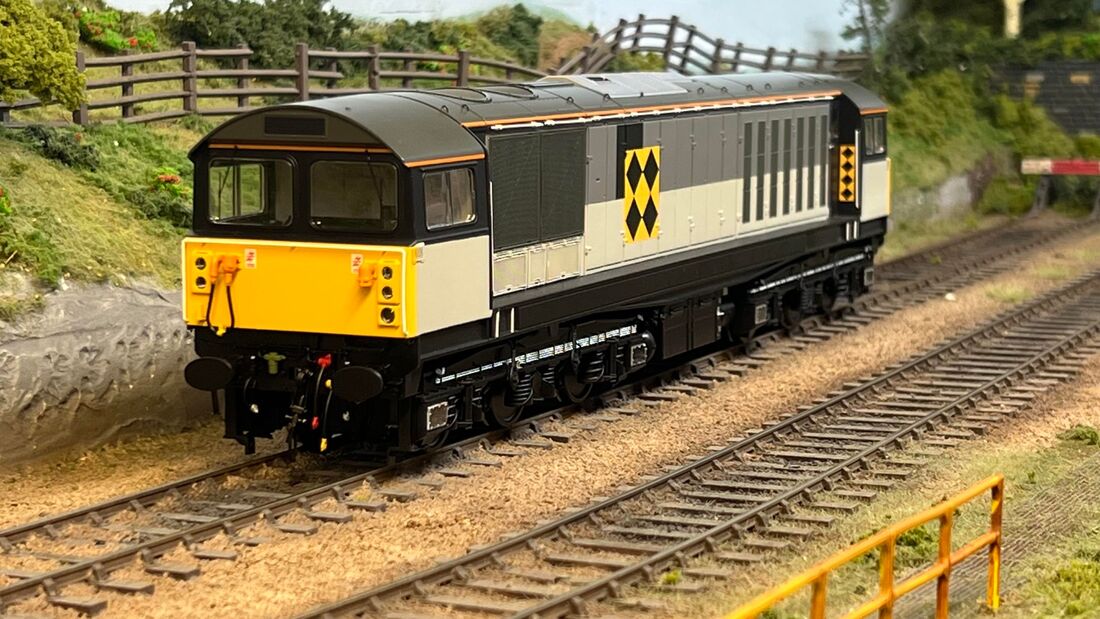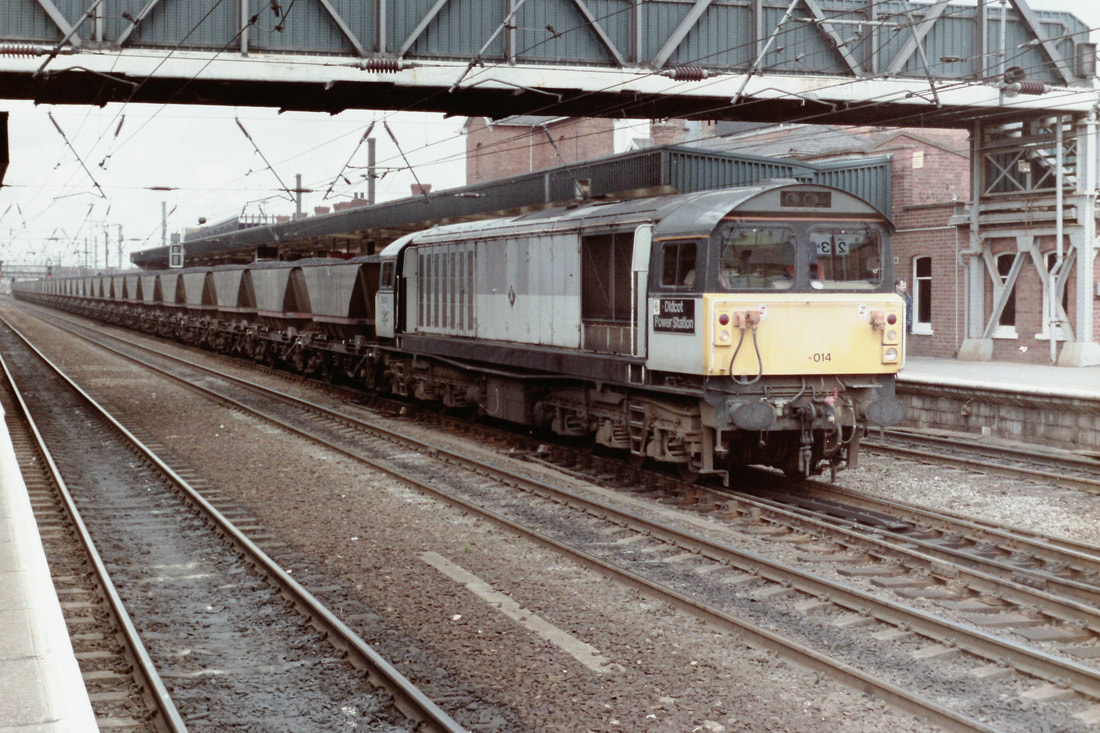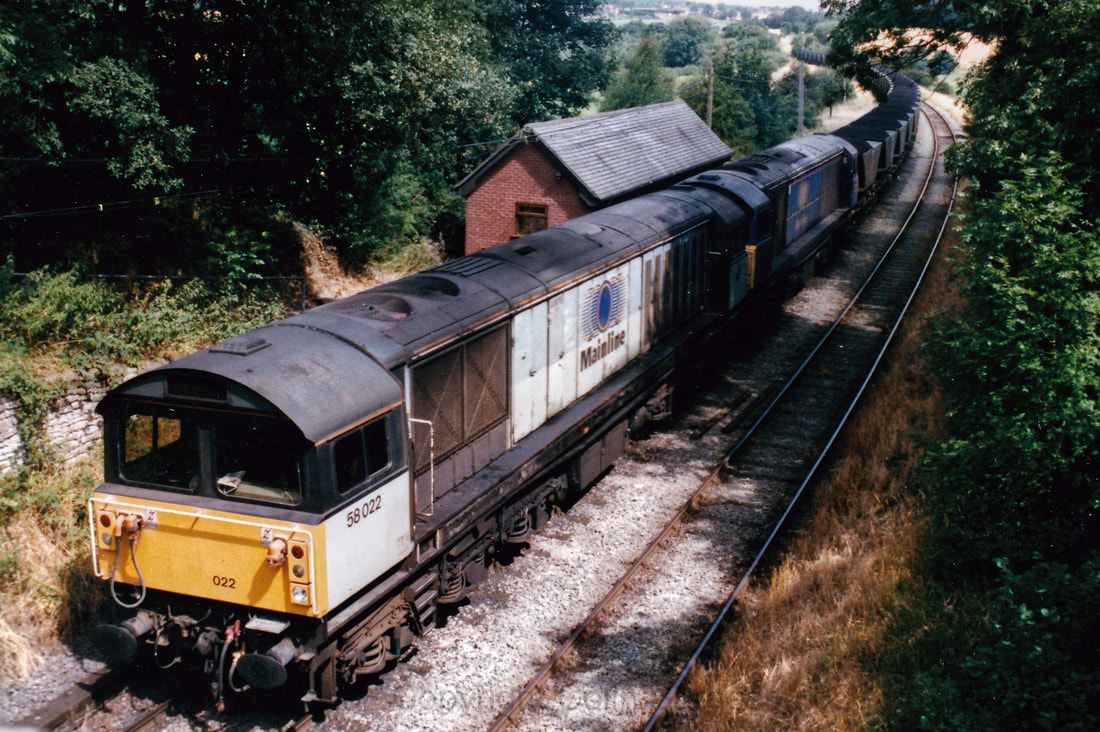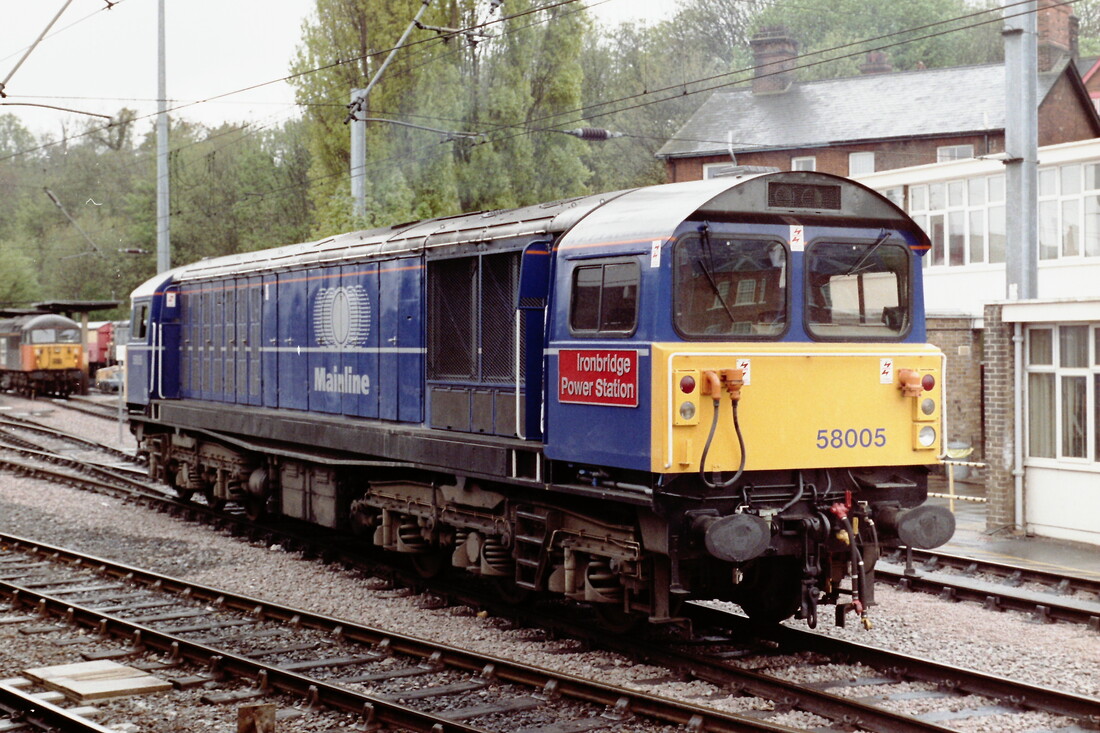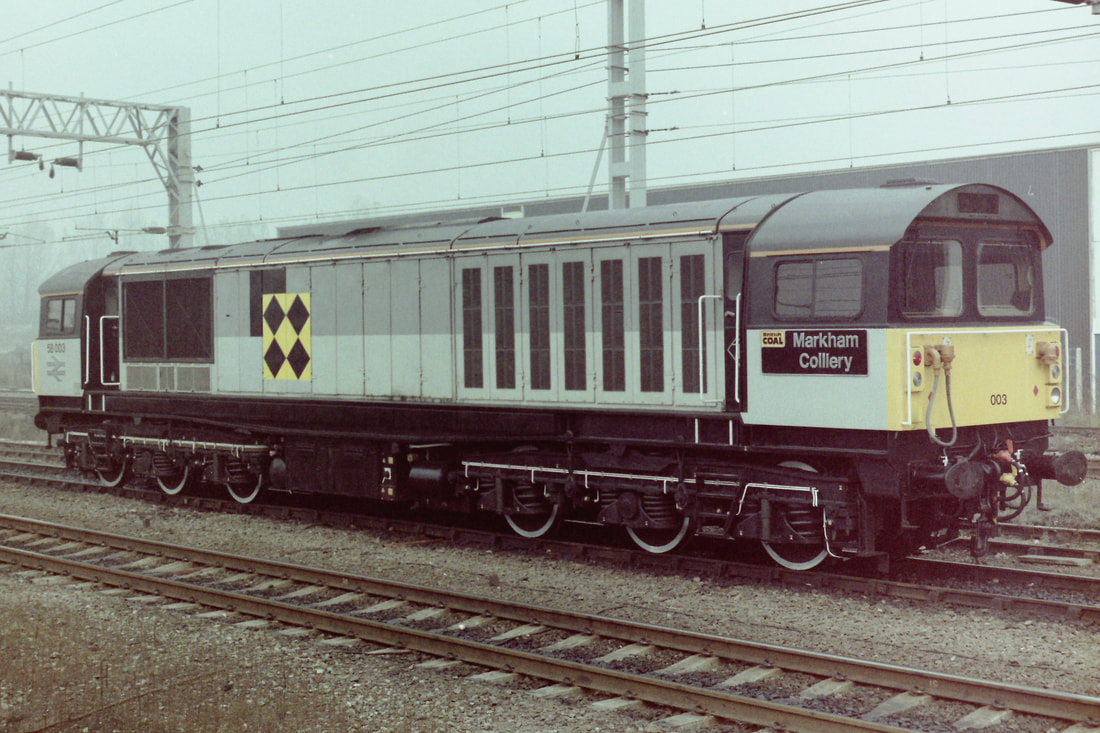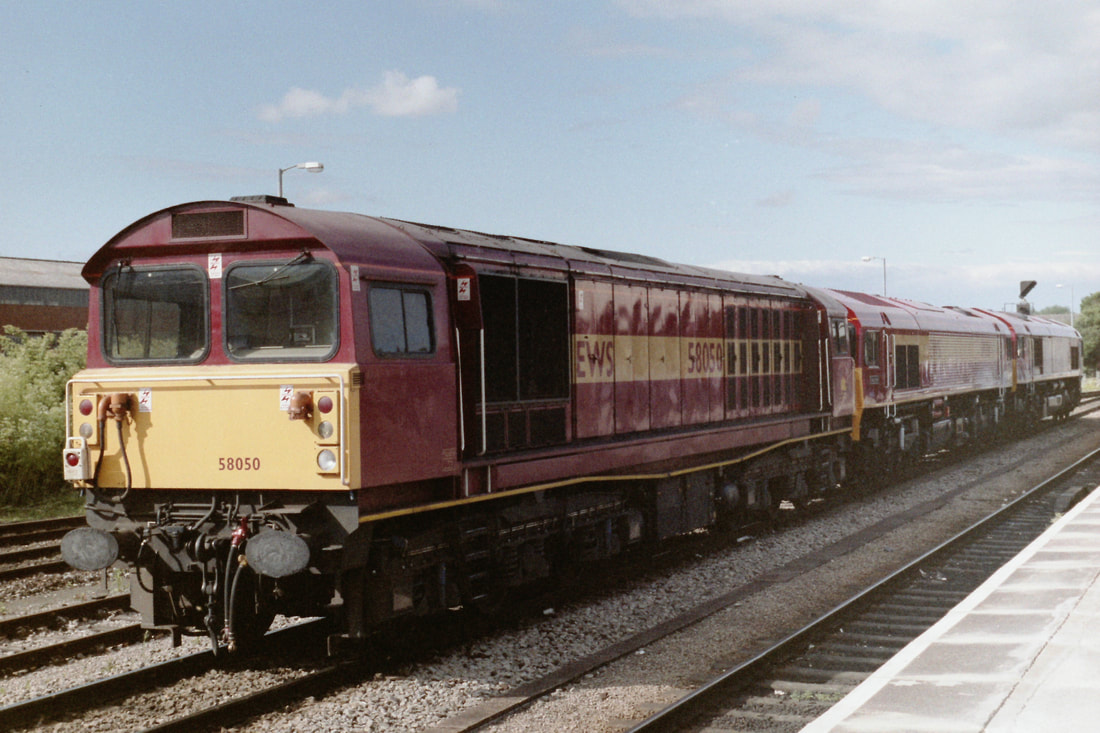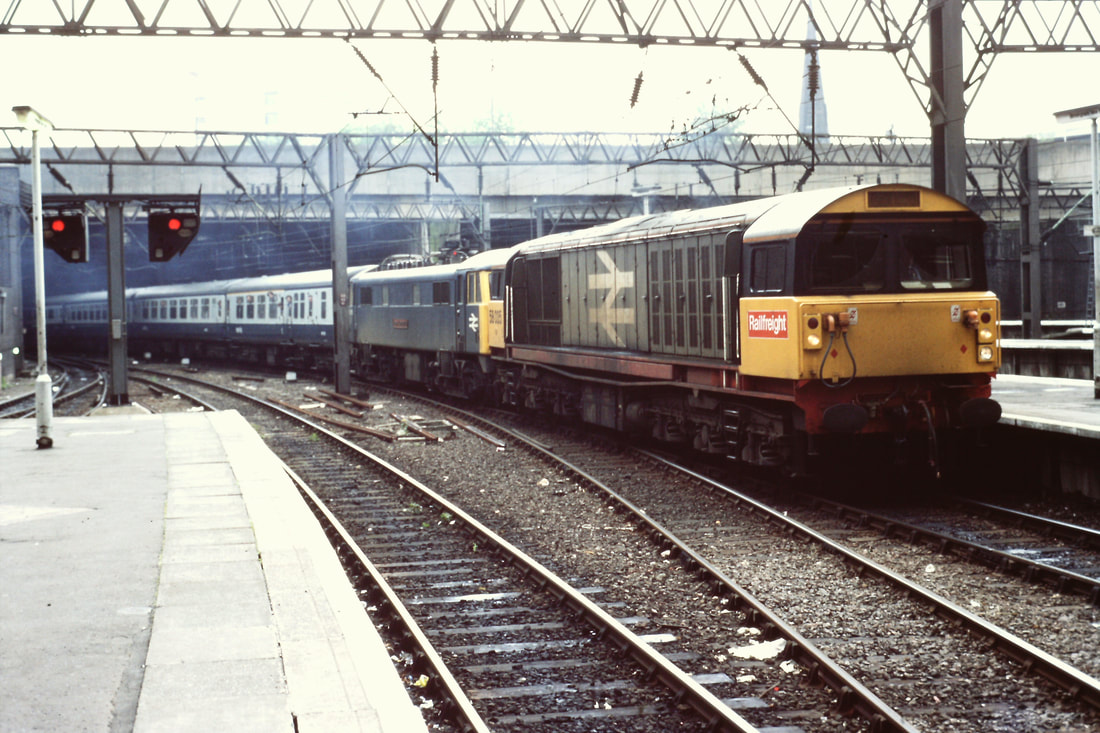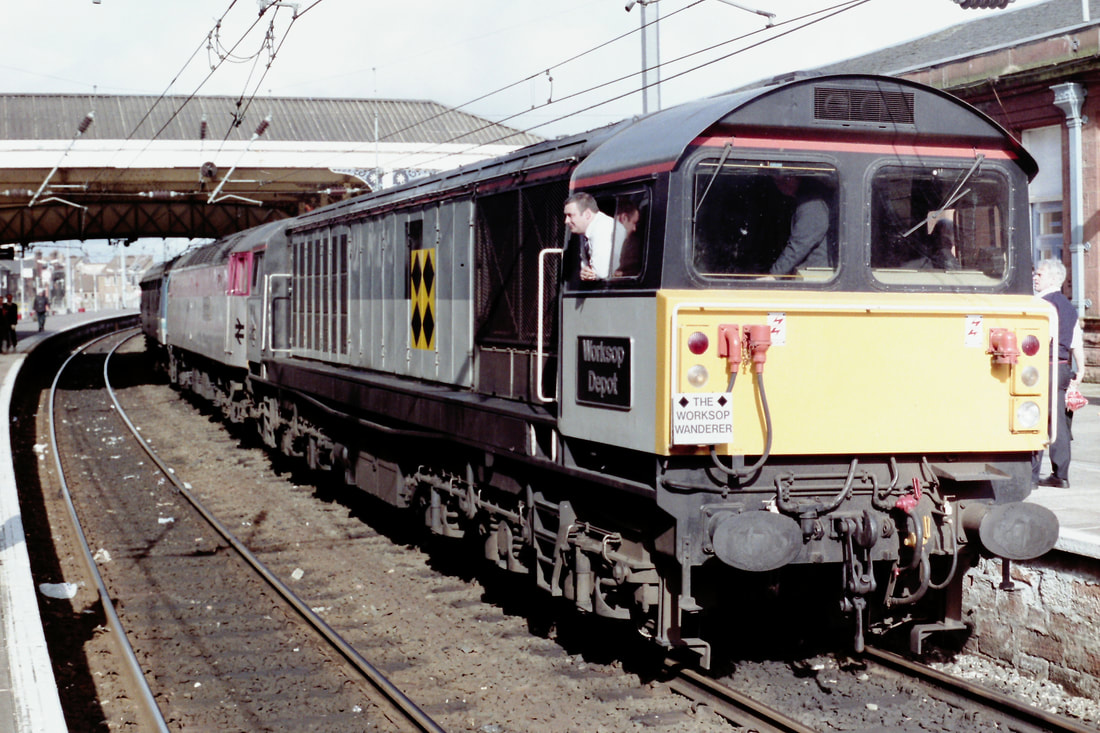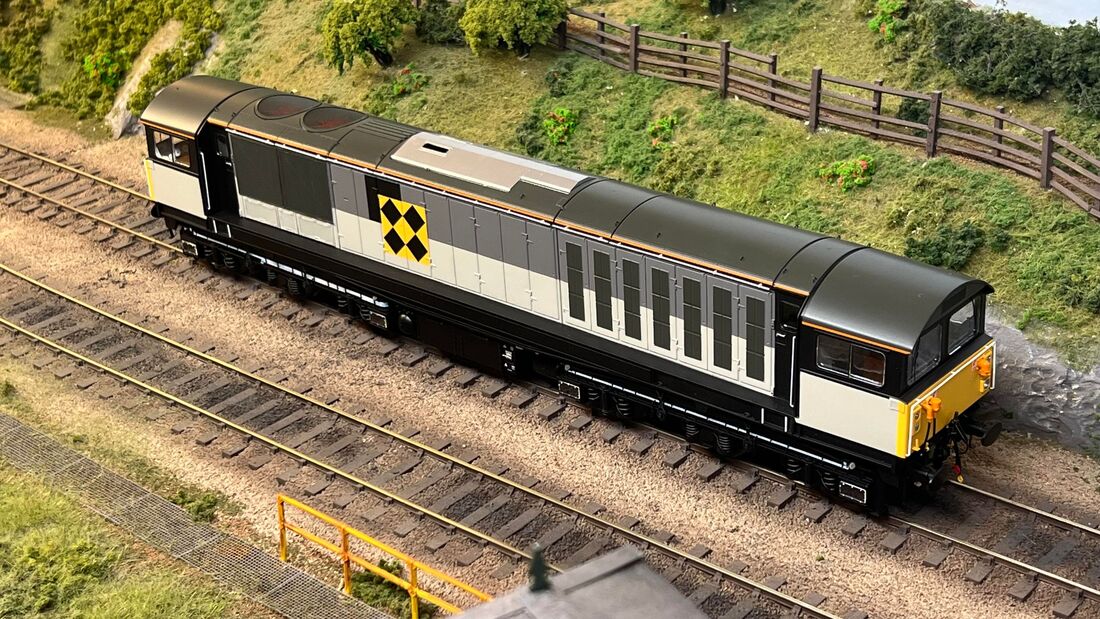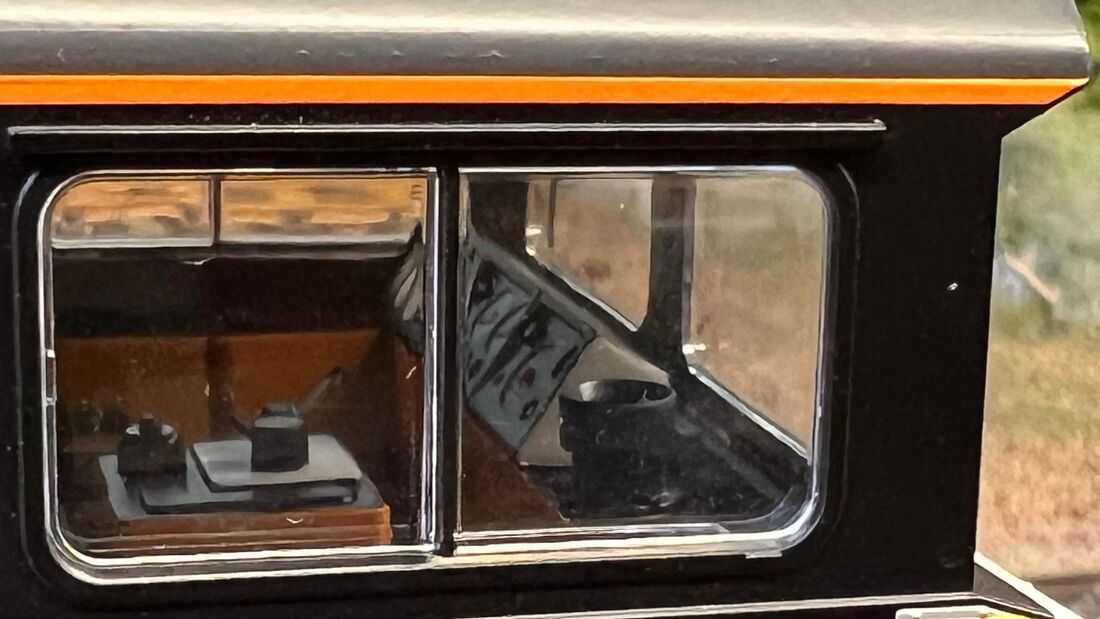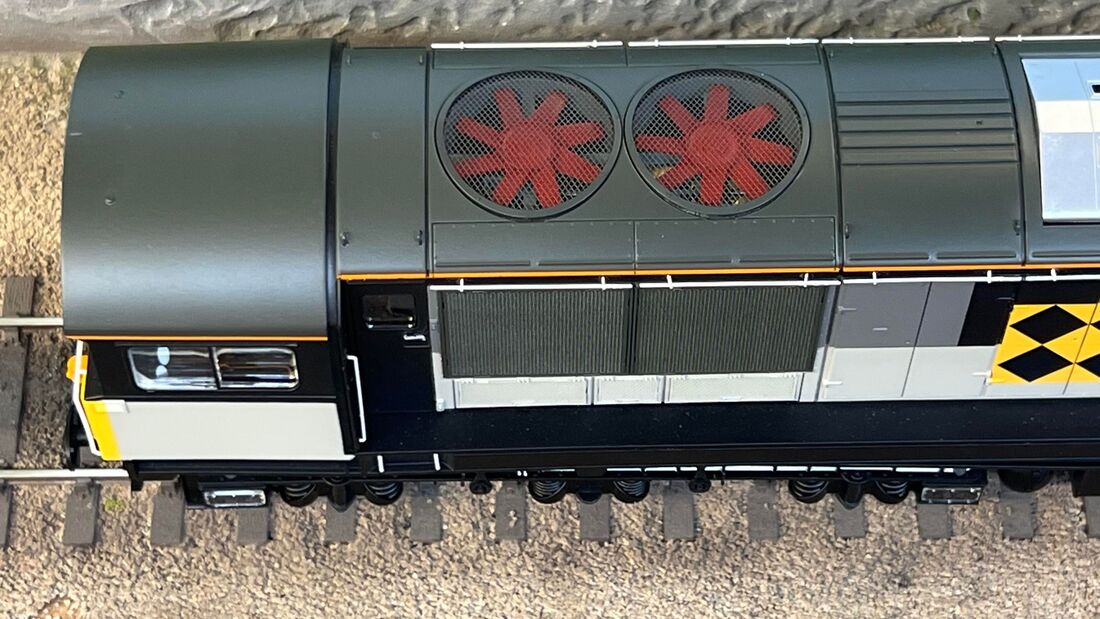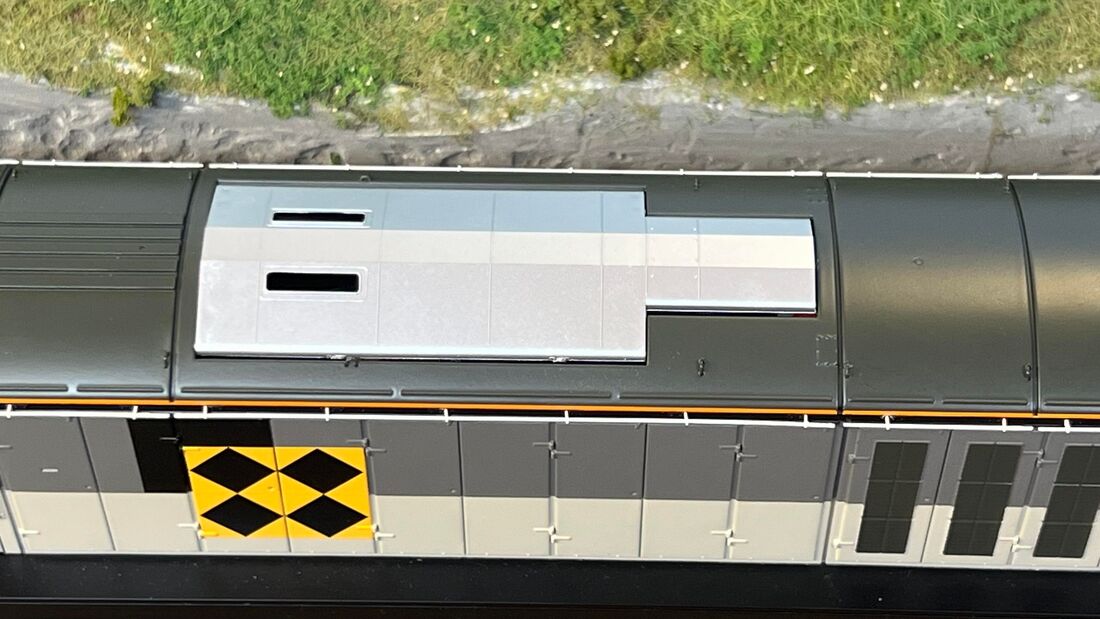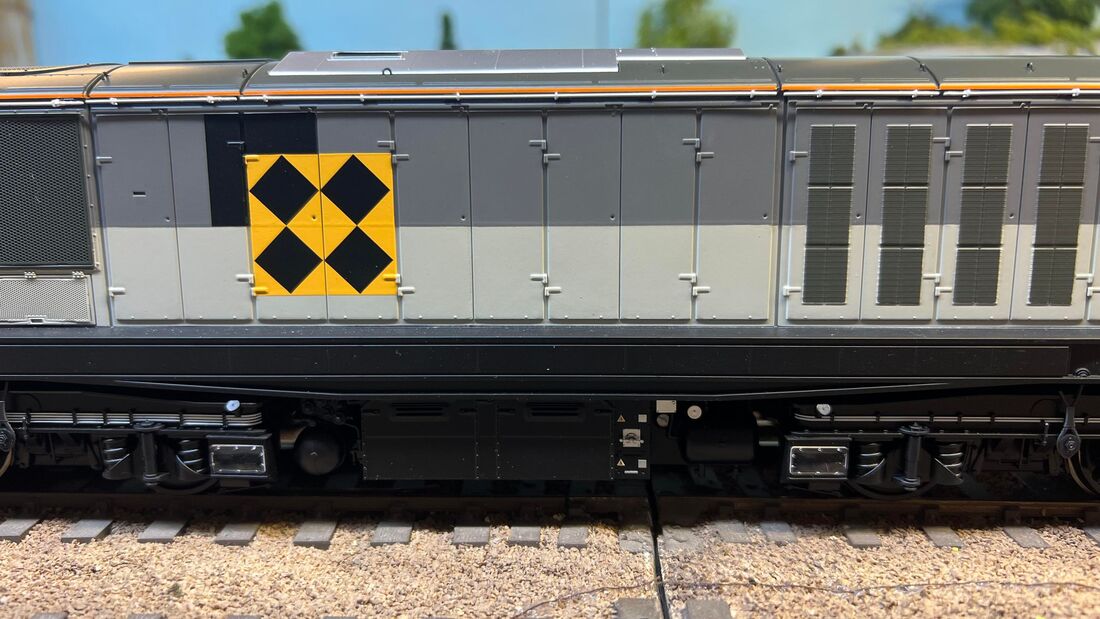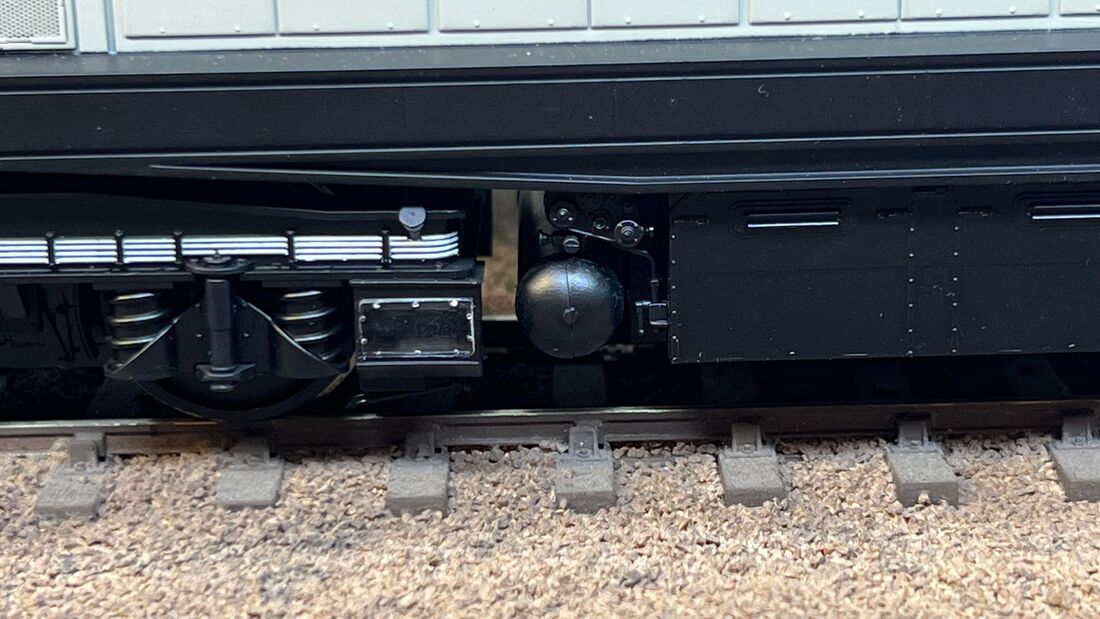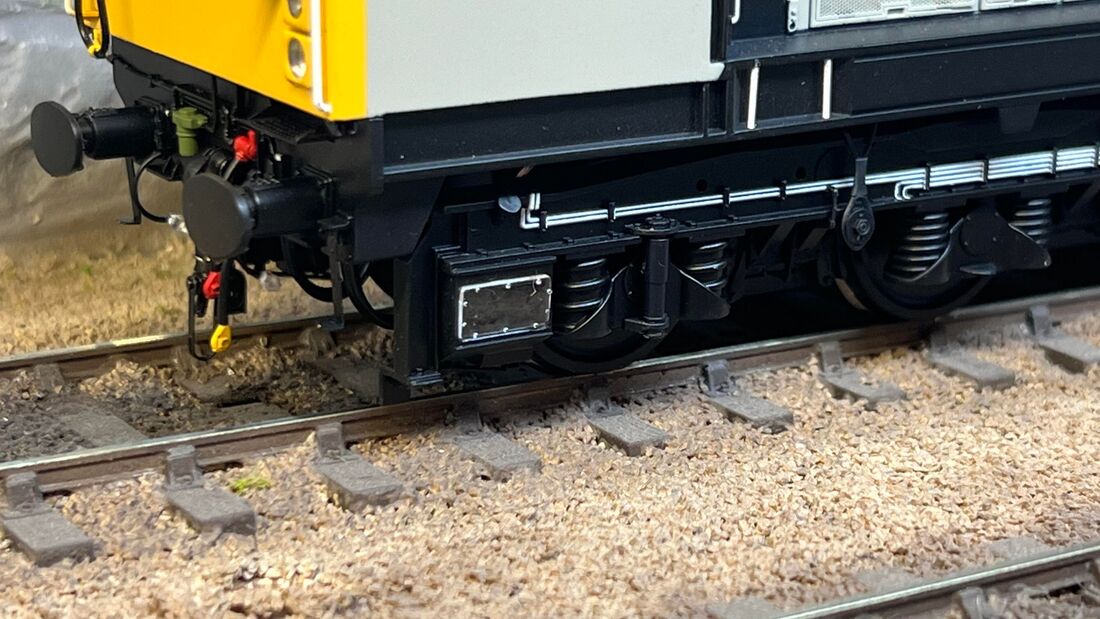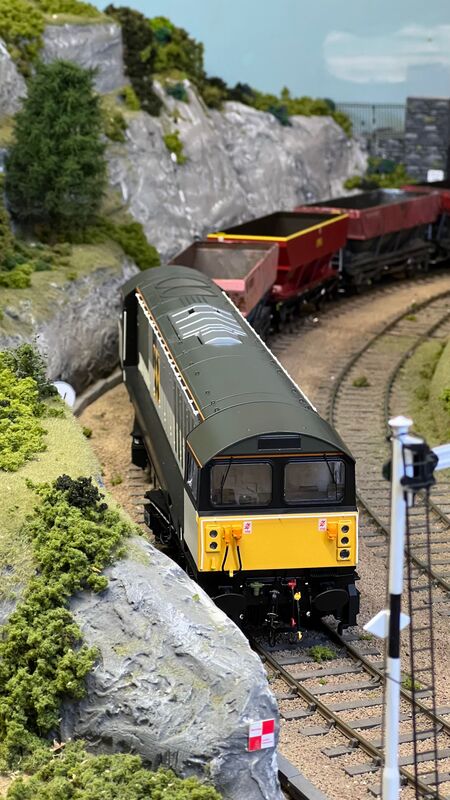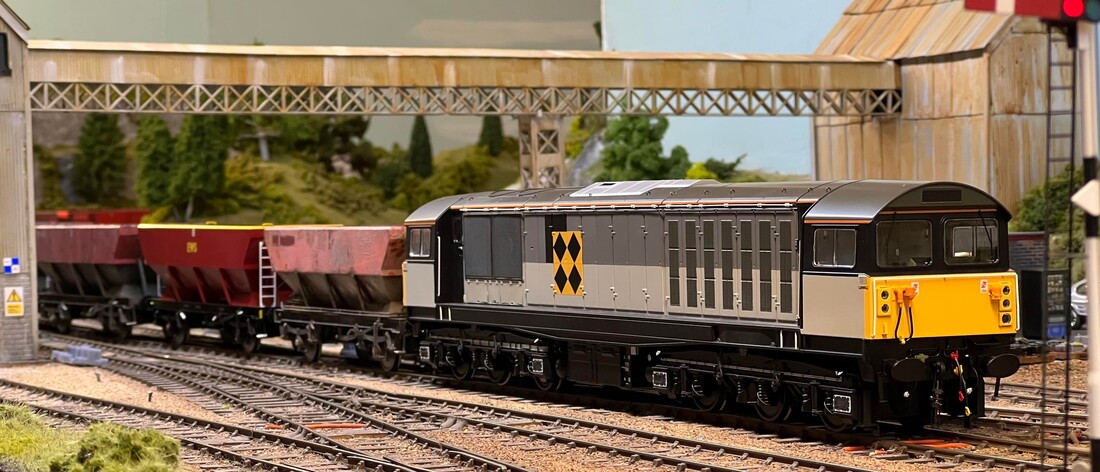|
Nine months old and 58001 sits on Toton TMD on 12th August 1984. Image courtesy of Alan Tait.
Review of Heljan Class 58
Thanks to Ben Jones of Heljan for loaning us a Triple Grey, Coal Sector Class 58 to complete this review. This review is based on my Heljan's Coal Sector class 58 and may not cover all the examples in production.
|
Class History.
In the late 1970’s dissatisfaction with fairly new heavy freight locomotive, the Class 56. Although only introduced from 1976 there was a move to improve on the 56, as they suffered from an increased failure rate and poor availability. This was considered far too high for a new design, even after teething issues. Major issues affecting the 56’s were excessive oil consumption and turbocharger failures. This led British Railway Engineering Limited (BREL) workshops to start look at developing a locomotive that was easier to maintain and cheaper to run. BREL were also looking at moving into the export market and the Class was designed with this market very much in mind.
It was hoped that the 58 would be the locomotive build that moved BREL into the export market and so the class would become known as the ‘Standard Export Locomotive’ (SEL). It was a novel design from UK railway workshops, designed from the frames up using a modular structure. It was hoped that this would allow a quicker, easier and cheaper build, also improving the maintenance access. The modules were bottled to the load bearing frame and incorporated the first Crash Test compliant cab in the UK. Between the cabs was a number of narrow body sections encompassing the Electrical Control units, Engine and Alternator. All sections having opening doors and lift off panels for ease of access to internal components. The design bears a close resemblance to a pair coupled nose to nose of the most reliable locomotives on the British network, the English Electric Class 20. They were rumours amongst the enthusiast fraternity at the time that a Type 3, Class 38 was also being considered for production. History tells us that this plan never got off the ground.
Once confident with the design an order for 35 units were placed with BREL in 1982 with construction allocated to Doncaster works. The first locomotive, 58001, was delivered in December 1983 with a further order for 15 more coming in 1984. They were considered a relative ‘success’ compared to the class 56. However drivers didn’t rate them the same as the accountants did, with excessive wheel-slip a major issue. This was put down to the simplistic design of the bogies. As a result, of this the last 15 were fitted with an improved design of bogies known as the CP3a. These had modified sanders and prominent sand boxes on the bogie corners. Later 58050 was fitted with an experimental Separately Excited (SEPEX) Traction Control system for a period of evaluation, there were no further examples fitted with this equipment and after a period it was removed and 58050 reverted to the standard format.
In a drive for reliability and increased economy, and to also increase competitiveness on the international market the Class 58’s were fitted with a 12-cylinder Ruston Paxman 12RK3ACT engine connected to a single Turbocharger producing 3,300hp. these loco's also used the same alternator and traction motors as the class 56. The four less cylinders gave an estimated 6% fuel saving over the 16-cylinder unit.
It was hoped that the 58 would be the locomotive build that moved BREL into the export market and so the class would become known as the ‘Standard Export Locomotive’ (SEL). It was a novel design from UK railway workshops, designed from the frames up using a modular structure. It was hoped that this would allow a quicker, easier and cheaper build, also improving the maintenance access. The modules were bottled to the load bearing frame and incorporated the first Crash Test compliant cab in the UK. Between the cabs was a number of narrow body sections encompassing the Electrical Control units, Engine and Alternator. All sections having opening doors and lift off panels for ease of access to internal components. The design bears a close resemblance to a pair coupled nose to nose of the most reliable locomotives on the British network, the English Electric Class 20. They were rumours amongst the enthusiast fraternity at the time that a Type 3, Class 38 was also being considered for production. History tells us that this plan never got off the ground.
Once confident with the design an order for 35 units were placed with BREL in 1982 with construction allocated to Doncaster works. The first locomotive, 58001, was delivered in December 1983 with a further order for 15 more coming in 1984. They were considered a relative ‘success’ compared to the class 56. However drivers didn’t rate them the same as the accountants did, with excessive wheel-slip a major issue. This was put down to the simplistic design of the bogies. As a result, of this the last 15 were fitted with an improved design of bogies known as the CP3a. These had modified sanders and prominent sand boxes on the bogie corners. Later 58050 was fitted with an experimental Separately Excited (SEPEX) Traction Control system for a period of evaluation, there were no further examples fitted with this equipment and after a period it was removed and 58050 reverted to the standard format.
In a drive for reliability and increased economy, and to also increase competitiveness on the international market the Class 58’s were fitted with a 12-cylinder Ruston Paxman 12RK3ACT engine connected to a single Turbocharger producing 3,300hp. these loco's also used the same alternator and traction motors as the class 56. The four less cylinders gave an estimated 6% fuel saving over the 16-cylinder unit.
|
58014 rattles through Doncaster on 6th April 1994 with an MGR service. Image courtesy of Alan Tait.
|
The entire class were allocated to Toton TMD from new. They were originally destined to work coal services from the Midland collieries, but they arrived during the miners’ disputes and found themselves on other duties including Freightliners, the Fletton Fly ash trains and Speedlink services. Once the dispute ended they returned to hauling coal trains across the Midlands. They were regular performers on MGR services made up of HAA wagons to Didcot, Cottam, Ratcliffe and Ironbridge power stations to name a few. They could also be found hauling rakes of HEA wagons on the Toton to Garston docks carrying export coal for Ireland via the North Staffordshire route. Sadly, the UK coal industry was doomed from the early 1980’s and the number of pits decreased over the next 20 years.
|
|
1994 saw both privatisation progressing in the rail industry and the coal industry, the entire class were allocated to the Mainline Sector. They continued to be regular performers on coal trains to and from the remaining midlands pits and power stations, but they also became regular performers on other goods services across the country. At this point, 30 were allocated to Toton, and 20 went to Eastleigh. The Eastleigh allocated locomotives became regular performers across the Southern counties working a variety of services including the Hallen Marsh to Furzebrook gas tanks, oil trains in and out of Ripple Lane, Steel strains to Sheerness, a plethora of engineering services. As well working heavy aggregate trains from Westbury to various locations and regularly making it into Devon with both Oil and Aggregate trains. . They could often be found stabled at Eastleigh and Westbury.
|
58022 & 58032 at Madeley Road on a Silverdale to Ironbridge service. on the 5th of August 1998 Image courtesy of Colin Burgess
|
With the arrival of EWS they class continued to work a variety of trains, but very little in the way of coal. It seemed a bizarre decision that EWS in 1999 that would place the majority of the fleet in to long term storage, by the end of 2002 they were all retired from UK service. During 2003 a number of EWS staff volunteered to paint 58001 back into its original colours for Doncaster Works Open Day, it subsequently did a few other depot visits. However this was not the end of their service as a number were exported to Europe to work engineering services in Spain and France as part of the massive investment in building new railways. A couple also went to the Netherlands for a period where they worked various services before returning to the UK.
A large number of class 58’s that stored in France and Spain, very few have been repatriated to the UK. The end is nigh for most of these locomotives with many already having received the attention of the cutters torch. Five have made it into preservation/private ownership for further use, 58022 survives in part being a donor locomotive for the LMS/Ivatt 10000 project.
A large number of class 58’s that stored in France and Spain, very few have been repatriated to the UK. The end is nigh for most of these locomotives with many already having received the attention of the cutters torch. Five have made it into preservation/private ownership for further use, 58022 survives in part being a donor locomotive for the LMS/Ivatt 10000 project.
|
Released into traffic carrying the Railfreight Grey, Red Sole bars and Black cabs, 58050 was the first to receive the triple grey paint scheme at Stratford in 1987. A few gained the Mainline Blue livery in 1994 with 58050 again being the chosen first locomotive for the new livery launch, whilst the majority attained the Mainline Transfers over the triple grey. From 1997 after the full privatisation of the railways many gained the EWS colours of Red and Gold, 58033 being the first with what became a non standard version of the livery carrying a higher gold band that what became standard and a black solebar. All locomotives that were exported gained the liveries of the companies they worked for, ACTS and VOS logistics in the Netherlands, GIF in Spain and Fertis, TSO & SECO Rail in France. It is ironic that a locomotive that was designed for the export market didn’t achieve any export sales for BREL but subsequently arrived on overseas soil after a number of services in the UK.
Top Right: 58001 at Knottingley after its heritage repaint on the 6th September 2008.
Middle Right: 58003 at Nuneaton on the 6th November 1988 waiting to work the 09.40 Euston - Shrewsbury. Image courtesy of Alan Tait. Bottom Right: 58050 waits to be towed away at Westbury on 28th June 1998 in EWS Livery. Image courtesy of Alan Tait. Below: 58005 coming off Ipswich depot on the 18th May 1996. Image courtesy of Alan Tait. |
|
58035 + 86215 arriving into Birmingham New Street on the 1st of June 1986with the 12.00 Euston - Shrewsbury. Image courtesy of Alan Tait
58011 + 47972 stand at Ayr on the 19th March 1994 after arriving with an 04.55 Manchester - Ayr Railtour. Image courtesy of Alan Tait
|
Because of the look of the locomotive the railway enthusiast fraternity affectionately started to call them “Bones”. The class was the last Diesel Locomotives to be built by BREL at Doncaster. When 58050 was delivered, it saw the end of locomotive construction on the Doncaster site and also Diesel locomotive production by BREL.
Due to their top speed of 80 mph, they were never popular with operators for substitution duties on express passenger trains. However, they have performed emergency rescues from time to time. Often been dispatched by Saltley depot to rescue errant trains including services hauled by electrics, diesel locomotives and HST units around the Birmingham area. 58002 made it as far as Plymouth assisting a Liverpool to Plymouth errant HST in 1984. 1992 saw a number of workings on the Birmingham - Cambridge services actually rostered for Class 58’s. They made regular forays on the Sunday Diversion Drags on the Birmingham New Street routes between on the Euston/Wolves services diverted from Nuneaton to New Street vice the usual Rugby - Coventry - Birmingham route or piloting trains over Cannock Chase. As a class they were also popular with enthusiast specials, often in top and tail or double headed formation and they took them to a variety of destinations, 58021 making it all the way South to Penzance (but not back again!) and 58002 & 58046 getting as far North as Aberdeen. During Mainline and EWS periods they could also be found on the VSOE British Pulman. |
What’s in the Box.
The model comes in the now familiar Heljan packaging mounted on plank surrounded by various density foam pieces and a clear plastic film. There’s an information leaflet that gives the dimensions of the locomotive in model size and in real life. The Scale size is correctly labelled for 1:43.5 scale. The leaflet gives a brief history of the class, how to remove the body for servicing and also how to add the optional extra push fit XL sound chip. There’s a small packet containing additional door baffle panels, handrails, NRN pods and footsteps for the consumer to add.
The Model
|
On first opening the box I must say that I was very impressed with overall appearance of the model. I feel it captures the class well, and looks every bit the part. At a quick glance everything looks to be in the correct place and with the right angles. I was impressed before removing it from the box. I reviewed the model starting from the typical Number 1 end and moved along to the body.
The cabs appear to have captured the correct profile of the prototype well, with square box hidden below the overhanging roof. The narrowing and tapering of the cab roof towards the front is captured nicely. The interior of the cab is also nicely modelled and visible through the windows. The cab desk the additional TPWS box on left-hand corner, this was not until after 1999 so is a strange addition. On the front are the nicely moulded working lights, multiple working jumper cables and the solitary lamp iron on the second man’s side. The air horn cover above the front windows is neatly moulded. A pair of windscreen wipers and hand rails are finely modelled. The cab corners carry the vents that were fitted to later built models above these are the side windows. Behind the cab is the driver door with a neatly moulded recessed handle. |
|
Next module is the bodyside radiator grills. Which are finely modelled, as are the hand holes and hinges. On the roof are the finely moulded motorised cooling fans that are visible below a fine mesh grill. Moving along the body to the Engine compartment. The individual doors are moulded nicely with hinges, but the model has holes for the T key opening rather than the door handles which were fitted after the first 15 had been built. This is not an oversight by Heljan, but a design choice due to a) the fragility of the parts and b) doors would get swapped around so any combination of handled/T Key accessed doors could be found on any loco after works attention, it was known for doors to also be replaced in the wrong order leading to some interesting livery variations. However after market parts are already available should you wish to add them. This area has a finely printed Coal Sector transfer. On the roof is mounted the large silencer block.
Finally. the electrical cubicle. The panels have finely moulded vents, and on the triple grey model these are picked out with the darker grey. Along the entire body section is a nicely moulded upper handrail just below the orange cantrail. |
|
The chassis is nicely moulded with extra details added to the heavy frame such as the air pipes. Below the frames are the battery boxes and equipment associated with the train air braking including the large air tanks. There are two types of bogies indicated in the instructions. The CP3 which was fitted initially to the first 35 and the CP3a, which were fitted to the rest. These were equipped with large sandboxes with clear fronts in order to aid adhesion. The bogies are nicely moulded, with the primary coil springs, brake rigging and the dampers are neatly moulded. The distinctive air pipes are nicely picked out in white.
Across the headstock are a screw coupling, some finely moulded control air pipes and brake pipes. And, of course, the large oval sprung buffers. There’s also the finely modelled cab end footsteps and the hefty lifeguards. The paint finish is excellent and there appears to be no bleed between the colours. All printing is neat and legible. Oddly enough the Data panel is not applied on the model I had for review, yet is shown on the artwork for the other models. |
Conclusion
|
The model was tested on the tight curves on Dovedale and with its good weight for adhesion it was able to haul a decent load even on the curves that are tighter than suggested in the instruction leaflet. The mouldings are crisp and printed details are sharp and it captures the prototype exquisitely. I feel this is one of the best models to come from the Heljan stable. As with all modelling it is important to do your research on the locomotive you plan to model as there were more variations in the 58's life cycle than you may think!
The model I had for review carries the modifications with CP3a Bogies and corner cab vents which appeared from 58036. The only minor issue I have with this model is the lack of handles for the panel release. The body panels model covers the first 15, so are missing from the model. In later years, some of the panels were interchanged between locomotives. Though I fully understand the logic behind this, if Heljan had included panel handles as an optional pack the model would be perfect. If I modelled the era that the model covers, I would probably purchase at least one, maybe more! This would be a fine addition to anyone's locomotive roster. |
Available liveries
Heljan have produced a number of models in the few colour schemes the class carried in UK service.
#5851 Railfreight ‘Red Stripe’ Class 58 unnumbered
#5853 Railfreight Coal Sector grey Class 58 unnumbered
#5854 EWS Red/Gold Class 58 unnumbered
#5855 Railfreight ‘Red Stripe’ 58034 Bassetlaw. Factory Weathered
#5857 Mainline Grey Class 58 unnumbered
#5858 Unbranded three-tone grey Class 58
There are also a number of limited editions from Tower Models and Gaugemaster:
#5850 Railfreight ‘Red Stripe’ 58042 Ironbridge Power Station. Tower Models
#5852 Railfreight Coal Sector grey 58014 Didcot Power Station. Tower Models
GM7240601 Mainline Blue 58021 Hither Green Depot. Gaugemaster
#5851 Railfreight ‘Red Stripe’ Class 58 unnumbered
#5853 Railfreight Coal Sector grey Class 58 unnumbered
#5854 EWS Red/Gold Class 58 unnumbered
#5855 Railfreight ‘Red Stripe’ 58034 Bassetlaw. Factory Weathered
#5857 Mainline Grey Class 58 unnumbered
#5858 Unbranded three-tone grey Class 58
There are also a number of limited editions from Tower Models and Gaugemaster:
#5850 Railfreight ‘Red Stripe’ 58042 Ironbridge Power Station. Tower Models
#5852 Railfreight Coal Sector grey 58014 Didcot Power Station. Tower Models
GM7240601 Mainline Blue 58021 Hither Green Depot. Gaugemaster
Proudly powered by Weebly
